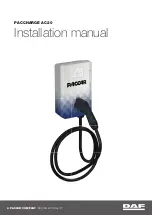
8
9
Maintenance and Storage
MILWAUKEE
battery packs will operate for
many years and/or hundreds of cycles when
they are maintained and used according to
these instructions.
A battery pack that is stored for six months
without being used will discharge itself.
Charge the battery every six months even if
it is unused to maximize battery life. Do not
tape the trigger in the “ON” position and leave
the tool unattended as this may discharge
the battery to a point where it will no longer
be able to recharge. Use a
MILWAUKEE
battery pack only until it no longer performs
with the power and torque needed for your
application.
Store your battery pack in a cool, dry place.
Do not store it where the temperature may
exceed 120°F (50°C) such as a vehicle or
metal building during the summer. High
temperatures will overheat the battery pack,
reducing battery life. If it is stored for several
months, the battery pack will gradually lose
its charge. One to three cycles of charging
and discharging through normal use will
restore the capacity of the battery pack. Dur-
ing the life of the battery pack the operating
time between charges becomes shorter. If
the operating time becomes extremely short
after a proper charge, the usable life of the
battery pack has been reached and it should
be replaced.
RBRC Battery Recycling Seals
The RBRC™ Battery Recycling Seals (see
"Symbology") on your tool battery packs
indicate that
MILWAUKEE
has arranged
for the recycling of that battery pack with
the Rechargeable Battery Recycling Cor-
poration (RBRC). At the end of your battery
pack's useful life, return the battery pack to a
MILWAUKEE
Branch Offi ce/Service Center
or the participating retailer nearest you. For
more information, visit the RBRC web site
at www.rbrc.org.
Disposing of NiCd Battery Packs
Nickel-Cadmium battery packs are recy-
clable. Under various state and local laws, it
may be illegal to dispose of this battery into
the municipal waste stream. Dispose of your
battery pack according to federal, state and
local regulations.
WARNING
To reduce the risk of explosion,
never burn a battery pack even if
it is damaged, dead or completely
discharged.
When to Charge the Battery Pack
For MILWAUKEE NiCd Battery Packs:
Charge your battery pack overnight before
you use it for the fi rst time and then when
your tool no longer performs with the power
and torque needed for the job. Never com-
pletely discharge the battery pack.
New battery packs reach full loading capac-
ity after 2-10 chargings and dischargings.
Battery packs which have not been used
for some time should be recharged before
use.
For MILWAUKEE Li-Ion Battery Packs:
Remove the battery pack from the tool for
charging when convenient for you and your
job.
MILWAUKEE
battery packs do not de-
velop a "memory" when charged after only
a partial discharge. It is not necessary to
run down the battery pack before placing it
on the charger.
•
Use the Fuel Gauge to determine when
to charge your
MILWAUKEE
Li-Ion bat-
tery pack.
•
You can "Top-Off" your battery pack's
charge before starting a big job or long
day of use.
•
The only time it is necessary to charge
the
MILWAUKEE
Lithium-Ion battery
pack is when the pack has reached
the end of its charge. To signal the end
of charge, power to the tool will drop
quickly, allowing you just enough power
to fi nish making a cut, drilling a hole, or
driving a fastener. Charge the battery
pack as needed.
Charge only MILWAUKEE 18-28V
Lithium-Ion battery packs and
MILWAUKEE 18V NiCd battery packs
in the MILWAUKEE Li-Ion/NiCd Bat-
tery Charger. Other types of batter-
ies may cause personal injury and
damage.
WARNING
How to Charge the Battery Pack
Place the battery pack onto the bay by slid-
ing the pack on from the top of the bay. The
red light will come on, either fl ashing (pack
is too hot or cold) or continuous (pack is
charging).
• For
MILWAUKEE
Li-Ion battery packs,
the Fuel Gauge lights on the battery
pack are displayed as the pack is being
charged, indicating how fully charged
the pack is.
•
A fully discharged pack with an internal
temperature in the normal range will
charge in about an hour (For Li-Ion,
between 32°F and 150°F; for NiCd, be-
tween 32°F and 140°F). Heavily cycled
battery packs may take longer to charge
completely.
•
After charging is complete, the con-
tinuous green light will come on. For
MILWAUKEE
Li-Ion packs, the Fuel
Gauge lights will go off. The Fuel Gauge
button won't work when the pack is on
the charger.
•
The charger will keep the battery pack
fully charged if it is left on the charger.
•
If the light indicator flashes red and
green, check that the battery pack is
fully seated into the bay. Remove the
pack and reinsert. If the light continues
to fl ash red and green, the battery pack
may be extremely hot or cold, or wet.
Allow the pack to cool down, warm up, or
dry out and then reinsert. If the problem
persists, contact a
MILWAUKEE
service
facility.
•
If the light indicator does not come on,
check that the battery pack is fully seat-
ed into the bay. Remove the pack and
reinsert. If the light indicator still does
not come on, contact a
MILWAUKEE
CHARGER OPERATION



































